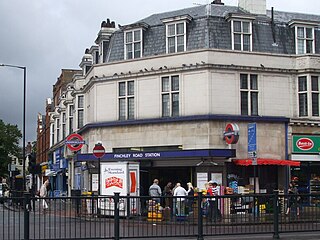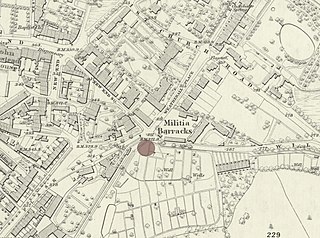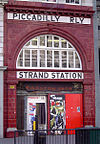
The Metropolitan line, colloquially known as the Met, is a London Underground line between Aldgate in the City of London and Amersham and Chesham in Buckinghamshire, with branches to Watford in Hertfordshire and Uxbridge in Hillingdon. Printed in magenta on the tube map, the line is 41.4 miles (66.7 km) in length and serves 34 stations. Between Aldgate and Finchley Road, the track is mostly in shallow "cut and cover" tunnels, apart from short sections at Barbican and Farringdon stations. The rest of the line is above ground, with a loading gauge of a similar size to those on main lines. Just under 94 million passenger journeys were made on the line in 2019.

The Bakerloo line is a London Underground line that runs from Harrow & Wealdstone in suburban north-west London to Elephant & Castle in south London, via the West End. Printed in brown on the Tube map, it serves 25 stations, 15 of which are underground, over 23.2 kilometres (14.4 mi). It runs partly on the surface and partly through deep-level tube tunnels.

The Jubilee line is a London Underground line that runs from Stanmore in suburban north-west London to Stratford in east London, via the Docklands, South Bank and West End. Opened in 1979, it is the newest line on the Underground network, although some sections of track date back to 1932 and some stations to 1879.

Baker Street is a London Underground station at the junction of Baker Street and the Marylebone Road in the City of Westminster. It is one of the original stations of the Metropolitan Railway (MR), the world's first underground railway, opened on 10 January 1863.

Wembley Park is a London Underground station in Wembley Park, north-west London. It is served by the Jubilee and Metropolitan lines and is in Travelcard Zone 4. On the Jubilee line the station is between Kingsbury and Neasden stations, and on the Metropolitan line it is between Preston Road and Finchley Road stations. It is located on Bridge Road (A4089) and is the nearest Underground station to exit for Wembley Stadium and Wembley Arena. This is where the Jubilee line to Stanmore diverges from the Metropolitan line, which was formerly a branch of the Metropolitan Railway and was taken over by the Bakerloo line and is now part of the Jubilee line.

Kilburn is a London Underground station near Brondesbury Park in north-west London. It is on the Jubilee line, between Willesden Green and West Hampstead stations and is in Travelcard Zone 2. The station is on the A5 Kilburn High Road or Shoot-up Hill, approximately 0.1 miles (0.16 km) north of Brondesbury station. Metropolitan line trains typically bypass the station without stopping.

Finchley Road is a London Underground station at the corner of Finchley Road and Canfield Gardens in the London Borough of Camden, north London. It is served by the Jubilee and Metropolitan lines and is located in Travelcard Zone 2. On the Jubilee line, the station is between West Hampstead and Swiss Cottage stations. On the Metropolitan line, it is between Wembley Park and Baker Street stations.

Swiss Cottage is a London Underground station at Swiss Cottage, north London. It was opened in 1939 as a stop on the Bakerloo line. Today, the station is on the Jubilee line between Finchley Road and St John's Wood stations. It lies in Travelcard Zone 2 and is located at the junction of Finchley Road, Avenue Road and College Crescent. The station is a local station, with the Metropolitan Line bypassing the station nearby.

St. John's Wood is a London Underground station located in St John's Wood in the City of Westminster, north-west London. It was opened in 1939 as a stop on the Bakerloo line. Today, the station is on the Jubilee line between Swiss Cottage and Baker Street stations and is in Travelcard Zone 2. Essentially, St. John's Wood station is a local station with the nearby Metropolitan Line bypassing this station. A Jubilee line journey between St. John's Wood and Baker Street typically takes less than three minutes.

Stanmore is a London Underground station in Stanmore, north-west London. It is the northern terminus of the Jubilee line and the next station towards south is Canons Park. The station is on the south side of London Road and is in Travelcard Zone 5.

The Metropolitan Railway was a passenger and goods railway that served London from 1863 to 1933, its main line heading north-west from the capital's financial heart in the City to what were to become the Middlesex suburbs. Its first line connected the main-line railway termini at Paddington, Euston, and King's Cross to the City. The first section was built beneath the New Road using cut-and-cover between Paddington and King's Cross and in tunnel and cuttings beside Farringdon Road from King's Cross to near Smithfield, near the City. It opened to the public on 10 January 1863 with gas-lit wooden carriages hauled by steam locomotives, the world's first passenger-carrying designated underground railway.

Lord's was a London Underground station located in St John's Wood, north-west London.

Marlborough Road is a disused London Underground station in St John's Wood, northwest London NW8, England. It opened in April 1868 on the Metropolitan & St. John's Wood Railway, the first northward extension from Baker Street of the Metropolitan Railway. It is located at the junction of Finchley Road and Queen's Grove.
The New Works Programme of 1935–1940 was the major investment programme delivered by the London Passenger Transport Board (LPTB), commonly known as London Transport, which had been created in 1933 to coordinate underground train, tram, trolleybus and bus services in the capital and the surrounding areas. The programme was to develop many aspects of the public transport services run by the LPTB and the suburban rail services of the Great Western Railway (GWR) and London and North Eastern Railway (LNER). The investment was largely backed by government assistance as well as by the issuing of financial bonds and was estimated to cost £42,286,000 in 1936.

There were a number of proposals to build an underground railway along the Edgware Road in north-west London, England, at the end of the 19th century. Each scheme envisaged building some form of rail tunnel under Edgware Road towards Victoria railway station.
The transport system now known as the London Underground began in 1863 with the Metropolitan Railway, the world's first underground railway. Over the next forty years, the early sub-surface lines reached out from the urban centre of the capital into the surrounding rural margins, leading to the development of new commuter suburbs. At the turn of the nineteenth century, new technology—including electric locomotives and improvements to the tunnelling shield—enabled new companies to construct a series of "tube" lines deeper underground. Initially rivals, the tube railway companies began to co-operate in advertising and through shared branding, eventually consolidating under the single ownership of the Underground Electric Railways Company of London (UERL), with lines stretching across London.
London's Metropolitan Railway (MR) amalgamated with other underground railways, tramway companies and bus operators on 1 July 1933, to form the London Passenger Transport Board (LPTB); the MR became the Board's Metropolitan line.

Paddington is a London Underground station served by the Bakerloo, Circle and District lines. It is located on Praed Street to the south of Paddington mainline station and has entrances from Praed Street and from within the mainline station. On the Bakerloo line the station is between Warwick Avenue and Edgware Road and on the Circle and District lines it is between Bayswater and Edgware Road. It is in London Fare Zone 1.

Hampstead was an authorised but unbuilt railway station in Hampstead, north London planned by the Metropolitan and St John's Wood Railway (M&StJWR).

Finchley Road was an authorised but unbuilt railway station in Frognal, north London planned by the Metropolitan and St John's Wood Railway (M&StJWR).




















